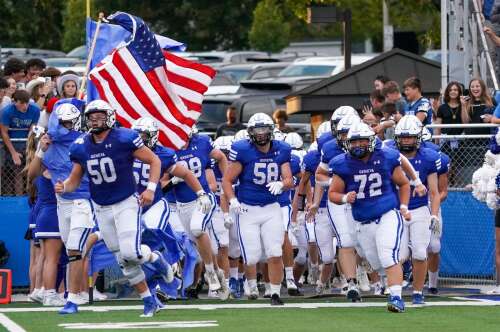Geneva takes the field before playing Larkin at Geneva.
Sean King/ For Shaw Local News Network, Aug. 30, 2024
I recently ran into a former IHSA standout football player who also happened to be a highly sought after recruit from Illinois in 2013. We had fun talking about his life these days while reflecting back on his high school football playing career and his college football recruiting process.
One thing that became really clear after that discussion is just how much the entire recruiting process has changed in such a short period of time.
Here are some examples of the biggest changes and how they have impacted prospects trying to charter the murky waters of the college recruiting process.
The recruiting process is getting earlier and earlier for prospects, parents, high school coaches and college teams. I don’t see that changing anytime soon.
Higher level Division 1 college coaches are now looking for a high school prospect as early as freshman season and even earlier in some cases. More and more elite level players, especially quarterbacks can claim to have added verbal offers in grade school.
Once upon a time, college coaches would visit a local high school and ask the coaches about their top seniors and juniors and those coaches would never consider discussing players who hadn’t seen playing time at the varsity level.
Now, college coaches insist on knowing those same underclassmen’s names as early as possible and in most cases those same college coaches have built up a multiyear relationship with those underclassmen and their families. Despite all the changes in recruiting, building relationships with coaches and players is still the bedrock the recruiting process is built on and the earlier you begin those relationships the better.
Making a college decision is also happening earlier.
A current Class of 2025 player is right now in the middle of his senior season, and for the most part the large majority of scholarship level recruits (Power 4/Group of 5/FCS and D2) in the class have verbally committed to a school and are planning to sign a letter of intent in early December. Even those underclassmen playing at high in demand positions are already committed including some key quarterbacks in the Class of 2026 from Illinois this fall.
The transfer portal has greatly impacted high school recruiting for the most part in a negative way. The portal allows college players to transfer from one school to another without penalty, and while this was seen to be a positive for current student athletes, its impact on high school recruiting has been felt. How so? Scholarships once considered mainly for prospects in high school have now allowed colleges to rebuild rosters with older, more experienced talent. In many cases the incoming transfer student has a track record at a previous college including film playing at the college level. High school prospects are competing with older transfer players for scholarships.
College programs now used the portal as a way to improve rosters faster without the need to develop high school players. While not all programs have refocused recruiting efforts completely toward transfers, nearly every program has a handful of transfers on the rosters and those numbers continue to grow.
Also one of the hottest subjects these days in the recruiting world is the development of name, image and likeness. College athletes (and in some small cases high school athletes) are now allowed to financially benefit from their name, image and likeness and in many ways this is still a growing subject still in the very early stages, especially at the high school level.
I’ve spoken to multiple high school coaches on NIL who for the most part take a very limited stance.
One high school coach — who wishes to not be identified — who has sent hundreds of players onto the Division 1 level said that he leaves it all up to the player and his parents.
“I tell the parents to make sure they get a good financial adviser and also a good lawyer since contracts will be involved,” he said. “I just feel like once you have families and money involved, I’m better off not being involved.
“I know of a few of these kids who are making life changing money already from NIL. I’m totally for it as long as the players are protected, but I can also see the other side of it where you can also run into a lot of problems and issues. I’m more than happy to sit on the sidelines for this and let the families take care of that business. I know a lot of other coaches feel the same.”
Yet everyone agrees that NIL will continue to grow and heavily impact college sports from here on out and that recruiting will also never stop changing.
